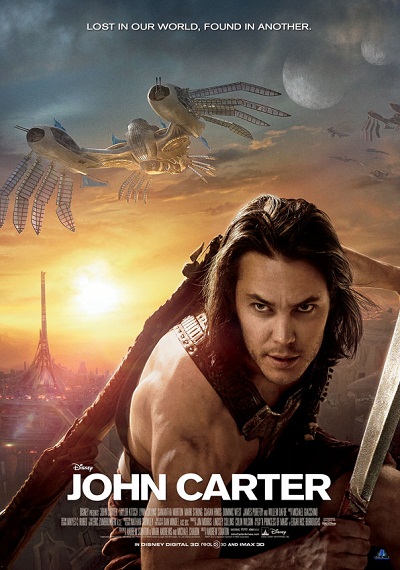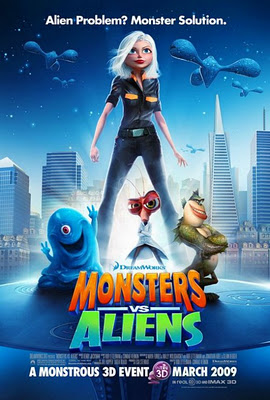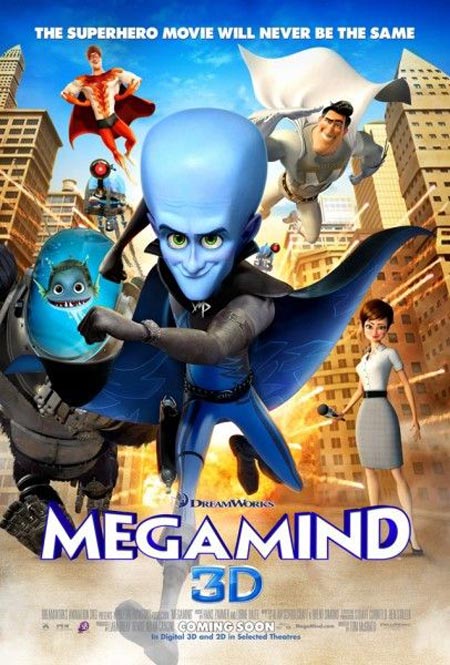 |
| Megamind (2010) |
Dreamworks’ animations, in my personal opinion, do some amazing portrayals of their female characters. Unlike other animation studios, where female characters have a cookie cutter personality and want to find true love, Dreamworks gives their female characters more goals than that. And one of my favorite–and I think one of the best examples of this–is Roxanne Ritchi from the movie Megamind.
The plot of Megamind is that he’s from a planet that was destroyed and his arch rival Metroman is from the neighboring planet which was also destroyed. While Metroman’s escape vessel lands in a good and wealthy home, Megamind’s vessel lands in a prison yard where he is raised by criminals. Not only that, but Metroman grows up with great social skills and is incredibly attractive, while Megamind has a hard time pronouncing certain words and doesn’t look at all human so he has a harder time trying to fit in. Consequently, Megamind grows up to be an evil villain while Metroman becomes the good superhero who always wins. We also have Roxanne Ritchi, our damsel in distress, who is constantly being kidnapped by Megamind and saved by Metroman.
If this plot sounds at all familiar, it is because it is a lot like Superman–with Superman being Metroman, Brainaic being Megamind, Lois Lane being Roxanne Ritchi and even Jimmy Olsen as Hal Stewart. I’ve personally always loved Lois Lane since I used to read a lot of the old Superman comics. Lois Lane was originally created in 1938. She was really dedicated to her work, she was very headstrong and stubborn and she rarely took orders from her male co-workers. But of course, she has earned the title of being the damsel in distress for being constantly saved by Superman. The fascinating thing about her, though, is her personality was created in the late thirties when none of those qualities were considered attractive for a woman. Even Superman wasn’t always attracted to her because of these traits.
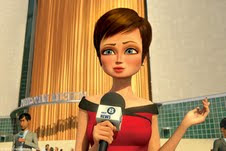 |
| Roxanne Ritchi, voiced by Tina Fey |
I’m only discussing Lois Lane because of her parallel self, Roxanne Ritchi, who can only really separate herself from Lois Lane because she does not love Metroman/Superman. Now of course, there have been several different portrayals of Lois Lane where she’s terrified when kidnapped or she is bored of it because it has happened so much. For Roxanne Ritchi, she’s been kidnapped so much by Megamind that even when she is sitting in a death machine she has no problem taunting the evil villain. She even blows a spider in his face.
In this specific kidnapping, we see that Megamind has (supposedly) killed Metroman and so he proceeds to take over the city. What I really love about Roxanne Ritchi comes out during this part of the movie, where she is the only news reporter to question Megamind, she insults him on air, and isn’t willing to stand around and do nothing.
She visits the Metroman-dedicated Museum where she runs into Bernard. Unknowingly to her, Megamind is also visiting the museum to say his last goodbyes to Metroman. He disguises himself as Bernard and has a heart to heart with Roxanne about how much he misses Metroman. It is through this conversation that Roxanne says, “Heroes are not born, they are created.”
Megamind takes this to mean that he can create a new superhero to fight while Roxanne takes her own advice and takes matters into her own hands. She does this by sneaking into Megamind’s lair, taking pictures, researching who Megamind is and also trying to duplicate the notes she found in his lair to understand what his ultimate plan is. While she’s doing all this, Megamind is actually accompanying her but is disguised as ‘Bernard’. Over time, Roxanne falls for ‘Bernard’.
I personally really love that this feeling for ‘Bernard’ wasn’t instant and that she had to slowly move past the mourning of a superhero (who she probably considered to be more of a friend than anything else) in order to really care for ‘Bernard’.
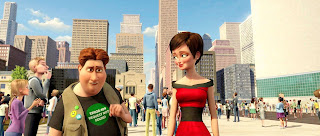 |
| Hal and Roxanne |
Now, Megamind has created a new superhero through Hal Stewart who I haven’t really discussed yet. Hal Stewart is Roxanne’s cameraman who loves Roxanne in that sort of creepy stalker way; he even has a poster of her saying good night to him above his bed. Roxanne, of course, is not at all interested but when Hal becomes a superhero he thinks everything is going to turn around. So he tries to woo Roxanne but that is dramatically unsuccessful. It could have been that he is still not her type or the fact that he was throwing her around like a football; I’ll let you decide on that.
After her encounter with the new Hal Stewart, she rushes to her date ‘Bernard’ and reveals what just happened. It is through this date that she kisses ‘Bernard’ but his disguise malfunctions and is revealed to be Megamind. (F.Y.I. This is one of the best kiss scenes I’ve ever seen.) What follows is one of my absolute favorite scenes in any movie ever, where Megamind tries to convince her to come back to him because she said never judge a book by its cover. Roxanne immediately counters that he killed Metroman, destroyed the city and is in fact evil. I personally love that Roxanne isn’t going to take any of this crap and does a good job reminding the audience that she has every reason to leave Megamind.
When we get to the end of the movie, Roxanne tries to reason with Hal because he is about to destroy the city. Hal has proven in very little time that he is much more threatening than Megamind ever was. What ends up happening, though, is that he ties her up to a building and calls out for Megamind to face him. But even now, when Hal is about to take down the entire building, Roxanne still tries to reason with him. This is the very essence of what it means to be a strong character. It is not actually about being physically strong, or incredibly intelligent; it is about still trying to accomplish your goal even when there is no hope.
Of course, Megamind saves her and the big epic fight scene happens between Hal and Megamind. At a certain point of the fight Megamind is losing and you can see Roxanne running up from behind with a broken metal sign. Which is amazing to see this character still have her goal of stopping Hal. Unfortunately, that is short-lived because when Hal throws Megamind up into the air, Roxanne drops her sign and gets backed up into a fountain where she has no weapon to defend herself. I can’t help but slap my face every time at this moment because she had every inch of determination in her face when she had that metal sign. She was clearly going to wham Hal with it. Even though she was going to lose that fight, she still had that raw determination.
I still don’t understand why she dropped that damn sign.
There is another little detail about this final scene that I’m going to sound like a jerk for pointing out but I really, really, really have to.
Her nails are polished pink.
Why do I point this out? Because she doesn’t have her nails done in any other scene. She didn’t have them done when she went out on her date with ‘Bernard’. So that means that at some point between realizing that the love of her life was actually a super villian and that the crazy stalker co-worker now is destroying the city, she got her nails done.
Maybe it wouldn’t bother me so much if it wasn’t already established that she didn’t put that much stock in her appearance. There are two times in this movie where her hair gets messed up or face is really dirty and she doesn’t take the time to fix it. She just goes on with her job or goes on her date.
But really, I take very few issues with the movie Megamind, and Roxanne is a fantastic character. She isn’t the main focus of the plot but the people at Dreamworks still took the time and thought to develop who she is, what her goals in life are, and what is going to motivate her through the story.
Even though Roxanne is pretty much the only female character of this movie, I want to take a second to talk about the great background characters. If anyone else noticed, the background characters, who are both male and female, come in many different sizes and races. I really want to point this out because there are other females who are bigger, have different shaped faces and don’t all look alike. Along with this, there are parts where there are a bunch of cops and the number of female cops is equal to the amount of male. And really, thank you Dreamworks for not putting the women cops in skirts, I really appreciate it. These all are very small details, but they do register in young kids’ minds.
When you have these small details and a great supporting character like Roxanne, you already have a great movie. There are many other reasons why Megamind is a great movie but seeing a well-rounded character like Roxanne is just so amazing. I’m so happy that children saw this movie where even the damsel in distress proves to have so much going on under the surface.
J. Lee Milliren is an active feminist currently in her last year at the Art Institutes International Minnesota where she will earn her bachelor degree in Media Arts and Animation. She takes a critical eye to how characters are portrayed in films.




